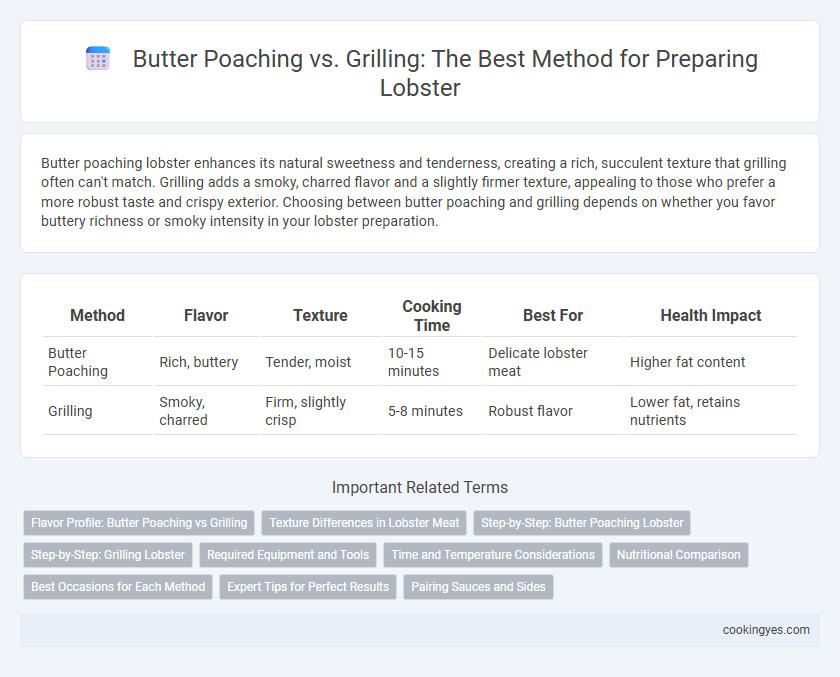Butter poaching lobster enhances its natural sweetness and tenderness, creating a rich, succulent texture that grilling often can't match. Grilling adds a smoky, charred flavor and a slightly firmer texture, appealing to those who prefer a more robust taste and crispy exterior. Choosing between butter poaching and grilling depends on whether you favor buttery richness or smoky intensity in your lobster preparation.
Table of Comparison
| Method | Flavor | Texture | Cooking Time | Best For | Health Impact |
|---|---|---|---|---|---|
| Butter Poaching | Rich, buttery | Tender, moist | 10-15 minutes | Delicate lobster meat | Higher fat content |
| Grilling | Smoky, charred | Firm, slightly crisp | 5-8 minutes | Robust flavor | Lower fat, retains nutrients |
Flavor Profile: Butter Poaching vs Grilling
Butter poaching lobster creates a rich, tender texture that enhances the natural sweetness with a creamy, buttery flavor. Grilling imparts a smoky, charred note that intensifies the lobster's briny essence, offering a robust and slightly caramelized taste. Both methods elevate the lobster's flavor profile distinctively, with butter poaching delivering subtle indulgence and grilling providing bold, savory complexity.
Texture Differences in Lobster Meat
Butter poaching lobster results in a tender, succulent texture, as the gentle heat preserves moisture and prevents the meat from becoming tough. Grilling lobster imparts a firmer, slightly charred texture with a smoky flavor, creating a contrast between the caramelized exterior and tender interior. The choice between butter poaching and grilling directly influences the lobster's mouthfeel, with poaching favoring softness and grilling enhancing a more robust bite.
Step-by-Step: Butter Poaching Lobster
Butter poaching lobster involves gently cooking the lobster tail in melted butter at a low temperature, preserving its tender texture and enhancing its rich flavor. Begin by melting clarified butter in a deep pan over low heat, ensuring it stays around 140degF (60degC) to avoid overcooking. Submerge the lobster tails in the warm butter for about 10-15 minutes, turning occasionally until the meat is opaque and tender, then serve immediately for a succulent, buttery finish.
Step-by-Step: Grilling Lobster
Grilling lobster involves first splitting the lobster in half and removing the intestinal tract to ensure a clean grilling process. Preheat the grill to medium-high heat, then brush the lobster meat with olive oil or melted butter to enhance flavor and prevent sticking. Place the lobster shells down on the grill for about 5-6 minutes, then flip the lobster meat side down and cook for an additional 3-4 minutes until fully opaque and charred edges develop.
Required Equipment and Tools
Butter poaching lobster requires a heavy-bottomed pan or skillet capable of maintaining a consistent low temperature and a thermometer to monitor the butter's heat, ensuring gentle cooking. Grilling lobster demands a grill or grill pan preheated to medium-high, along with tongs for flipping and a brush to apply oil or marinade for optimal char and flavor. Both methods benefit from kitchen shears or a sharp knife to split the lobster for even cooking and presentation.
Time and Temperature Considerations
Butter poaching lobster requires low and precise temperatures around 130degF to 140degF, cooking gently over 15 to 20 minutes to preserve delicate texture and flavor. Grilling lobster demands higher heat, typically 400degF to 450degF, with a shorter cooking time of 5 to 7 minutes per side to achieve a charred exterior while preventing overcooking. Careful control of time and temperature ensures optimal succulence and taste in both butter poaching and grilling methods for lobster.
Nutritional Comparison
Butter poaching lobster preserves more of its natural moisture and essential omega-3 fatty acids compared to grilling, which can cause some nutrient loss due to high heat exposure. Grilling imparts a smoky flavor but may reduce vitamin B12 and sensitive antioxidants present in lobster meat. Choosing butter poaching enhances the retention of healthy fats and water-soluble vitamins, promoting a more nutritious seafood meal.
Best Occasions for Each Method
Butter poaching lobster is ideal for intimate dinners or gourmet events where delicate flavor and tender texture are desired, making it perfect for upscale dining experiences. Grilling lobster suits casual outdoor gatherings and seafood barbecues, as the method imparts a smoky char and firm bite, enhancing the lobster's natural sweetness. Choosing between these methods depends on the occasion's ambiance and the desired flavor profile.
Expert Tips for Perfect Results
Butter poaching lobster ensures tender, succulent meat by gently cooking it in clarified butter at low temperatures, preserving its natural sweetness and delicate texture. Expert chefs recommend maintaining the butter between 140-160degF to avoid overcooking, while infusing with garlic and thyme for enhanced flavor. Grilling lobster imparts a smoky char and caramelizes the sugars, but requires precise timing to prevent dryness, with a 3-4 minute per side approach over medium-high heat considered ideal for perfect results.
Pairing Sauces and Sides
Butter poaching lobster enhances its tender texture and delicate flavor, making it ideal for pairing with rich, creamy sauces like garlic herb butter or lemon beurre blanc, complemented by sides such as roasted asparagus or garlic mashed potatoes. Grilling lobster imparts a smoky, charred taste that pairs well with tangy, zesty sauces like chimichurri or spicy aioli and side dishes including charred corn or Mediterranean salad. Both methods highlight distinct flavor profiles that elevate lobster when served with sauces and sides tailored to their unique cooking styles.
Butter poaching vs Grilling for lobster preparation Infographic

 cookingyes.com
cookingyes.com